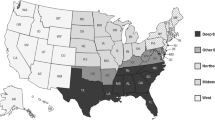Abstract
To determine whether CDC-funded HIV testing programs are reaching persons disproportionately affected by HIV infection. The percentage distribution for HIV testing and diagnoses by demographics and transmission risk group (diagnoses only) were calculated using 2013 data from CDC’s National HIV Surveillance System and CDC’s national HIV testing program data. In 2013, nearly 3.2 million CDC-funded tests were provided to persons aged 13 years and older. Among persons who received a CDC-funded test, 41.1 % were aged 20–29 years; 49.2 % were male, 46.2 % were black/African American, and 56.2 % of the tests were conducted in the South. Compared with the characteristics of all persons diagnosed with HIV in the United States in 2013, among persons diagnosed as a result of CDC-funded tests, a higher percentage were aged 20–29 years (40.3 vs 33.7 %) and black/African American (55.3 vs 46.0 %). CDC-funded HIV testing programs are reaching young people and blacks/African Americans.
Similar content being viewed by others
References
Centers for Disease Control and Prevention. Monitoring selected national HIV prevention and care objectives by using HIV surveillance data—United States and 6 Dependent Areas—2013. 2015;20(2). http://www.cdc.gov/hiv/library/reports/surveillance/. Accessed 31 Dec 2015.
Marks G, Crepaz N, Janssen R. Estimating sexual transmission of HIV from persons aware and unaware that they are infected with the virus in the USA. AIDS. 2006;20(10):1447–50.
Marks G, Crepaz N, Senterfitt JW, Janssen R. Meta-analysis of high-risk sexual behavior in persons aware and unaware they are infected with HIV in the United States: implications for HIV prevention programs. J Acquir Immune Defic Syndr. 2005;39(4):446–53.
Cohen MS, Chen YQ, McCauley M, Gamble T, Hosseinipour MC, Kumarasamy N, et al. Prevention of HIV-1 infection with early antiretroviral therapy. N Engl J Med. 2011;365(6):493–505.
Skarbinski J, Rosenberg E, Paz-Bailey G, Hall HI, Rose CE, Viall AH, et al. Human immunodeficiency virus transmission at each step of the care continuum in the United States. JAMA Intern Med. 2015;175:588–96.
Centers for Disease Control and Prevention. HIV Surveillance Report, 2013; vol 25. Atlanta, GA. February 2015. http://www.cdc.gov/hiv/library/reports/surveillance/. Accessed 31 Dec 2015.
U. S. Census Bureau. Total Population 2013 [December 16,2015]. Available from: http://factfinder.census.gov/faces/tableservices/jsf/pages/productview.xhtml?pid=ACS_13_1YR_S0101&prodType=table.
Centers for Disease Control and Prevention. HIV testing at CDC funded sites United States, Puerto Rico, and U.S. Virgin Islands, 2011. Atlanta, GA: 2013.
Harrison KM, Kajese T, Hall HI, Song R. Risk factor redistribution of the national HIV/AIDS surveillance data: an alternative approach. Public Health Rep. 2008;123(5):618–27.
Johnson AS, Beer L, Sionean C, Hu X, Furlow-Parmley C, Le B, et al. HIV infection - United States, 2008 and 2010. MMWR Surveill Summ. 2013;62(Suppl 3):112–9.
Prejean J, Song R, Hernandez A, Ziebell R, Green T, Walker F, et al. Estimated HIV incidence in the United States, 2006–2009. PLoS One. 2011;6(8):e17502.
An Q, Prejean J, Hall HI. Racial disparity in U.S. diagnoses of acquired immune deficiency syndrome, 2000–2009. Am J Prev Med. 2012;43(5):461–6.
Inungu J, Lewis A, Mustafa Y, Wood J, O’Brien S, Verdun D. HIV testing among adolescents and youth in the United States: update from the 2009 behavioral risk factor surveillance system. Open AIDS J. 2011;5:80–5.
Committee on Pediatric AIDS, Emmanuel PJ, Martinez J. Adolescents and HIV infection: the pediatrician’s role in promoting routine testing. Pediatrics. 2011;128(5):1023–9.
Centers for Disease Control and Prevention. Stigma and Discrimination: National Center for HIV/AIDS, Viral Hepatitis, STD, and TB Prevention; 2010 [updated March 10, 2015; cited 2015 March 16th]. http://www.cdc.gov/msmhealth/stigma-and-discrimination.htm.
Latkin CA, Vlahov D. Socially desirable response tendency as a correlate of accuracy of self-reported HIV serostatus for HIV seropositive injection drug users. Addiction. 1998;93(8):1191–7.
Acknowledgments
The authors would like to thank all of the participating health department and localities.
Author information
Authors and Affiliations
Corresponding author
Ethics declarations
Conflicts of Interest
The authors have no conflicts of interest to disclose.
Rights and permissions
About this article
Cite this article
Krueger, A., Dietz, P., Van Handel, M. et al. Estimates of CDC-Funded and National HIV Diagnoses: A Comparison by Demographic and HIV-related Factors. AIDS Behav 20, 2961–2965 (2016). https://doi.org/10.1007/s10461-016-1293-1
Published:
Issue Date:
DOI: https://doi.org/10.1007/s10461-016-1293-1




